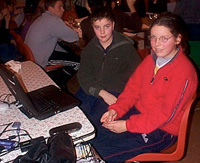Dooagh Primary School is situated on the beautiful West coastline of Achill Island in the village of Dooagh. In Gaelic Dooagh is Du Acha and means black planes, maybe referring to the fields of peat in the area. Dooagh Primary School has 59 pupils and three teachers. The children are aged between 4 and 12 and come from the surrounding villages of Keel, Pollagh, and Dooagh.
Forty years ago, before the emmigration of islanders reached ist peak, Keel had its own primary school with 60 children while the school at Dooagh had 140. The population numbers continued to drop until about five years ago. Dooagh has now employed a third teacher due to an increase in primary school children requiring places at the school. The numbers will remain stable at 59 children for the next couple of years.
We visited two classes where the children asked us questions about our various countries of origin (the UK, Sweden, Iran, and Germany). The older children demonstrated their musical skills by playing the tin whistle and accordion. They are preparing the music for St. Patrick�s Day celebrations that will take place in the village.
We took digital pictures and left our web adress of the project to the kids so they will be able to see the pictures on the net. Before we left some children wanted us to ask their teacher to cancel homework for that day ... their request was granted.
by Hashem Savoji
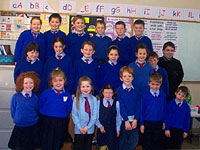
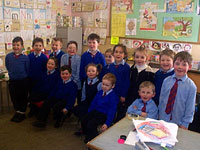
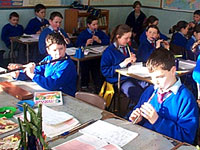
When planning our stay on Achill Island Judith came up with the idea of making a children's trail in the community of Keel after having seen various versions in Fulda near her home. The trail would be for children visiting the area during the holidays, and there should also be a virtual trail on the webpage for children exploring Ireland via the internet. We had hoped to produce something educational but fun.
Information about Keel and Achill was found in the "Achill Island Map and Guide" by Bob Kingston, and in the book "Achill: 5000 B.C. to 1900 A.D., Archaeology, History, Folklore" by Theresa McDonald. These references gave us some ideas for when we went to explore the village on foot ourselves.
Four of us, Judith, Thomas, Laura and Helen, had spent Tuesday walking around the village looking for other interesting aspects to include in the trail. That evening we put all our ideas together and designed a circular walk around the village with questions to be answered at different points of interest along the map.
On Wednesday Judith, Laura and Jerry spend the afternoon drawing all kinds of different illustrations before the trail was then put onto the computer by Thomas and Helga. Once on the computer we can print copies for the children to use when they are here on the island, and we can also make a virtual trail for the internet.
by Helen Silk
Starting point is the supermarket and post office in the centre of Keel. Follow the numbers on the map inside.
Yesterday, I went to the IT centre with some of the International Group who are visiting our Island. While I was in the IT centre, finally with a helping hand and trial and error I made a webpage. Learning how to make a page is a very interesting and enjoyable experience. Once you have the basic codes it is just a matter of practise. You learn how to make up the structure of the webpage first and then you elaborate on that. You can include pictures, coloured fonts, flashing words, backround colours , charts and you can practise your artistic talents to the best of your ability. Laying out the page, planning the appearance, choosing the subject, is all part of it. Of course, before that you have to know and learn, the html codes. They are not very difficult even though, they look like a different language!!!You will soon get used to them. A basic page would be like this:
<html>
<head>(you open the "head ")
<title>( the title you give to the webpage)
</title>( you close the "title")
</head>(you close the "head")
<body>(here comes the text and images you want to present on the web)
</body>(you close the "body")
</html>
As you can see you have to open and close each html code.Open=( ) Close=(/ ) That is only the structure of the page.There are many more html codes. I hope I have given a brief introduction on how to make a web-page and I sincerely hope you will find this interesting.
by Shuna Daly (13), daughter of the Wayfair Hostel's landslords
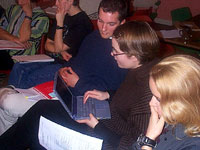
On Wednesday night the Wayfarer was the scene of international conflict on a large scale. It was time for the international quiz. The social organizers had worked hard to put together questions from all the countries represented in the group. Everyone had eaten a good dinner and was ready for the contest. The first challenge was for the organizers to split the group into five international teams, making sure that everone had a fair number number of people from each country - taking into account that some of the German group were Iranian, some of the English group were Greek and one of the Swedish group was sort of English.
After the minor skirmish of assigning the teams, serious battle commenced. Many people found themselves suddenly uncertain of who they were! The questions were divided into a certain number from each country represented and members of the team from that country were supposed to remain silent while the others answered. This proved rather difficult for some and there were some noisy exchanges between the groups. There was a great deal of heat generated in the exchanges. As the questioning progressed rather large areas of what could be described as "knowledge wasteland" were revealed, much to everyone's embarrassment. Perhaps it was a case of information underload!
It emerged that the name of the lake between Iran and the former Soviet Union was not the Red Sea, the common Finnish word taken into English was not "kippis" or vodka, that the real name of Count Dracula was not Monte Cristo and that the Daly's dog was not called Hanna. Surprise and disbelief all round!
The winners were finally named as team 5 who then went off to enjoy the taste of victory in the form of a pint each at the Village Inn. The losers accepted their defeat gracefully - the contest ended in peace and understanding and possibly increased understanding through improved knowledge in our international - intercultural group.
Our thanks to the organisers Hanna, Pari and Seppo for an enjoyable "battle".
by Pat Shrimpton
Dr. Laurent Borgmann
Last modified by:Marc-Michael Fuchs
